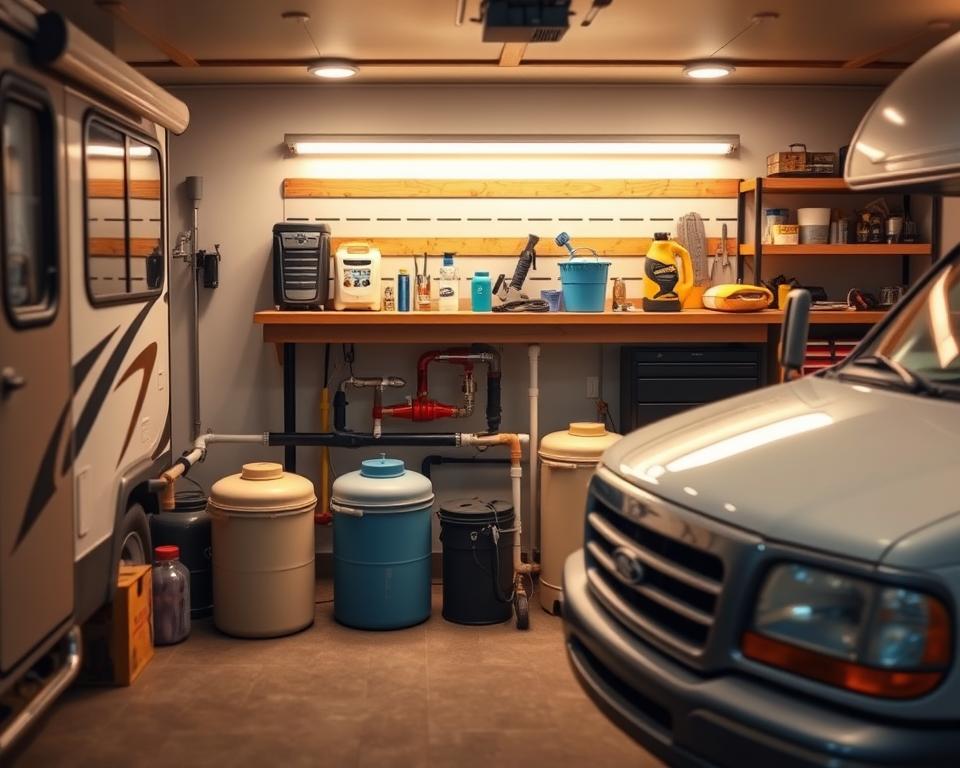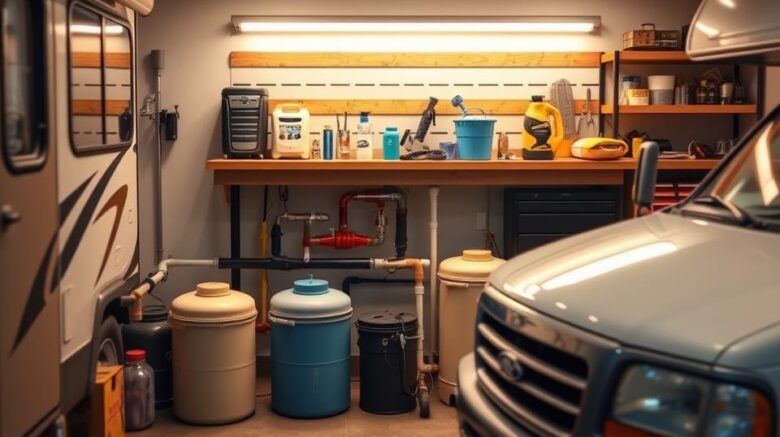RV Black-Water Pump: Essential Service Guidelines
Are you sure your motorhome’s black water pump is trip-ready, or could it trigger campsite headaches? Preserving your motorhome’s waste system in excellent order is imperative. It lets you avoid unpleasant aromas, back-ups, and costly repairs. This guide provides important advice to ensure your sewage pump operates smoothly, making your travels serene.
Grasping Your RV’s Plumbing System
The RV plumbing system is integral for any smooth journey. It breaks down into two main parts: the black water system and the gray water system – pump for RV holding tank. The black water system captures waste from the toilet, and the gray water system manages wastewater from sinks and showers.
The systems use drain lines that empty into different tanks, designed for efficient waste management. Each tank has a vent to block gas from building up, ensuring the operation is safe and pleasant. Proper waste management in an RV is vital to forestall leaks or bad odors. By learning about both black and gray water tanks, RV owners can service and manage waste better.
Understanding how your RV’s plumbing works allows early detection of issues promptly. Scheduled maintenance creates carefree adventures for everyone. Taking initiative with your RV’s plumbing system assures reliability during your travels.
Water-Holding Tank Types
Traveling in RVs involves being aware of the different tanks. Each one is essential to your RV’s operation, requiring regular upkeep.
The fresh water tank stores cook-and-drink water. It’s essential for a convenient RV experience.
The gray water tank holds sink, shower, and other non-Septic wastewater. Handling this tank keeps your RV hygienic while traveling. The black water tank, on the other hand, contains toilet waste. It needs consistent emptying and diligent maintenance to avoid issues.
By understanding the fresh, gray, and black water tanks, RV owners can better handle their systems. This strategizing and steady maintenance secure smooth operation of the waste management system.
How RV Black Water Tanks Work
The working of the black water tank is crucial in RV waste management. It stores waste from the toilet via a gravity-fed system. Upon flushing, waste and water are guided toward the tank, to be stored until removal is necessary. It’s critical to keep water levels optimized in the toilet to stop solid waste buildup.
Knowing how RV waste tanks function can avoid clogs and odors. Without proper care, solid waste hardens, producing blockages and emptying difficulties. Effective tank flushing techniques are key to preventing these issues, ensuring smooth functionality.
Routine inspection of tank mechanics is advised for RV owners. This includes monitoring flushing methods and sustaining adequate water flow. Practicing these essentials aids in efficient tank maintenance, heading off expensive fixes later.

Essential Maintenance Tips for Your RV Black Water Pump
Carrying out regular maintenance on your RV’s black water pump is vital. Kick off by using RV-safe toilet paper to cut down clogs and boost flow. A deep flush can eliminate waste and diminish bad smells. Regularly cleaning the tank helps avoid residue buildup, ensuring your RV clean and comfortable.
Run regular inspections to examine your pump’s condition. Look for any signs of wear or damage that could hinder its function. Using specialized tank treatments, like those from All in Sanitation, can significantly boost both performance and cleanliness. Sticking to these tips can prolong your pump’s life and better your RV’s living conditions.
Use RV-Safe Toilet Paper
Keeping your RV’s black water system includes vital steps. One prime tactic is using RV-safe toilet paper for clog prevention. This purpose-made product dissolves quickly in water, tailored for RV sanitation systems.
RV-safe toilet paper is crucial for tank maintenance. It dissolves fast, stopping blockages from slow-decomposing materials. This betters waste disposal efficiency and keeps the plumbing clear.
Pick brands designated as RV-safe when buying toilet paper. These products diminish clog risks and boost your black water tank‘s lifespan by avoiding buildup. Regular use ensures a stress-free camping experience, absent plumbing troubles.
Flush the Tank Thoroughly
Flushing thoroughly your black water tank is key for proper waste management in your RV. To assist waste movement, ensure the toilet bowl is sufficiently watered before flushing. Many RVs are equipped with built-in tank flush systems to make the process more effective. For RVs without this feature, using tank rinsers that attach to the sewer outlet offers a reliable alternative.
Correct tank flushing assists waste removal and stops solid accumulations and bad smells. Adhering to this process ensures your RV stays odorless, making your travels more comfortable. A focus on regular and complete tank flushing will enhance hygiene and the overall condition of your RV’s plumbing system.
Keep Tanks Clear with Steady Cleaning
Maintaining your RV’s black water tank free of buildup is essential for its efficient function. Routine cleaning eliminates lingering waste inside the tank walls. This means washing well with water and using specific RV tank cleaners for tough deposits.
By cleaning regularly, you halt odors and minimize clog risks. A well-maintained tank makes RVing better and helps your plumbing last longer. Incorporate tank maintenance into your routine to secure smooth travels.
Selecting Safe Treatments
Choosing appropriate chemicals for RV black water pump maintenance is key for managing waste and minimizing smells. Many RV enthusiasts employ enzyme-based RV holding tank treatments. These products feature good bacteria to degrade solids and reduce bad odors.
Shunning harsh chemicals is critical to prevent damage to your plumbing. Such substances can damage pipes, leading to expensive repairs and diminishing your RV enjoyment. Utilizing safe chemicals for odor control protects your tank and pump’s longevity.
Holding your RV black water tank in top condition enhances your travel experience. Using the right holding tank treatment consistently ensures your system works well.
Timely Tank Emptying
It’s vital to empty your RV’s black water tank at the proper level for smooth emptying. Aiming to do so when the tank is about two-thirds full is prudent. This stops solid waste buildup, ensuring a quicker emptying process.
Disposing waste at authorized stations is critical for safe, eco-friendly waste handling. It’s essential to keep an eye on the tank‘s levels closely. Letting it fill completely can result in clogs and make disposal more difficult.
Right intervals and procedures are vital for hygienic waste management and can increase your plumbing’s life. Remaining attentive and doing proper upkeep delivers a pleasant RV living experience.
Inspect and Maintain Seals
Checking seals around the toilet and tank is important for leak prevention. Over time, these seals might deteriorate, leading to odors and potential harm. A careful inspection will uncover any wear or damage. Spotting issues early makes possible quick replacement to guarantee a secure connection and odor-free RV.
Maintaining a bit of water in the toilet bowl supports in preserving seal condition. This preventative measure is critical in RV seal upkeep. It prolongs the seals’ life, preventing leaks and foul odors.
Regular seal maintenance can avoid costly fixes later. By prioritizing seal health, RV owners ensure a pleasant journey.
Additional Tips for Long-Term Maintenance
Arranging professional servicing for your RV at least once a year is smart, particularly for black water tank care. This strategy helps in early problem detection and protects your plumbing system’s integrity.
When getting your RV for storage, thoroughly clean and empty the black water tank first. Use antifreeze to protect from damage from remaining water during cold seasons. Following this practice is essential for safeguarding the system, ensuring it’s ready for your next adventure.
Frequent audits and preventive actions are vital to extending your sanitation system’s life. Paying close attention to connections, hoses, and seals secures smooth operations. This mindset enhances your RV experience, making it enjoyable all year round.
Ensuring your RV’s black water pump is well-maintained is vital for a stress-free camping journey. By observing the maintenance tips shared, you can maintain your black water system running smoothly. It’s vital to focus on consistent tidying, applying correct flushing methods, and choosing appropriate chemicals for waste management.
By hitting these maintenance requirements, you will eliminate unpleasant odors and blockages. This also increases your RV plumbing system’s durability. Proactive care of the RV black water pump means more time enjoying the outdoors, without concern for potential setbacks.
Remember, proper upkeep is key next time you gear up for an outing. It’s not the highlight of RV ownership, yet it significantly enhances your travel experience.
